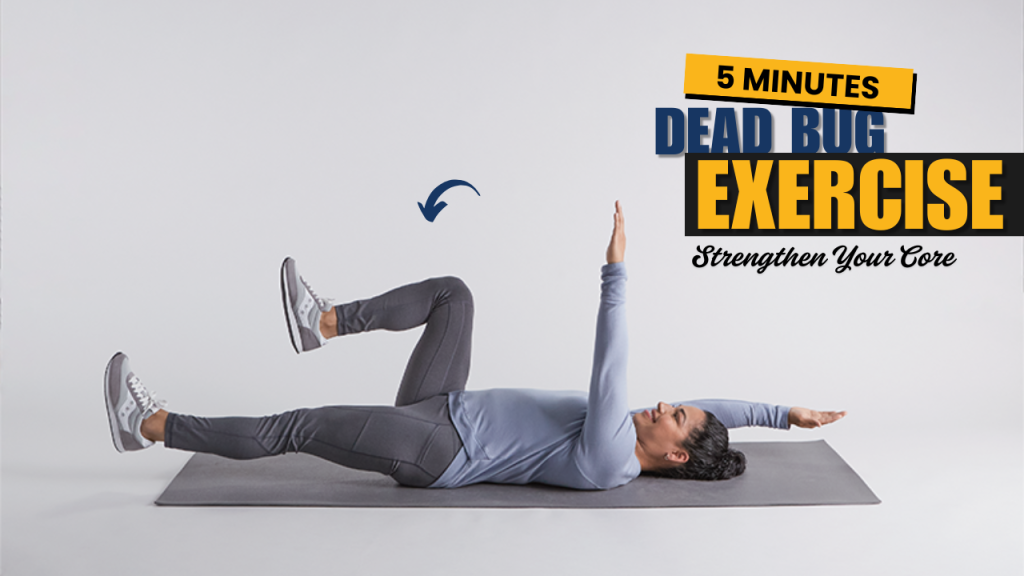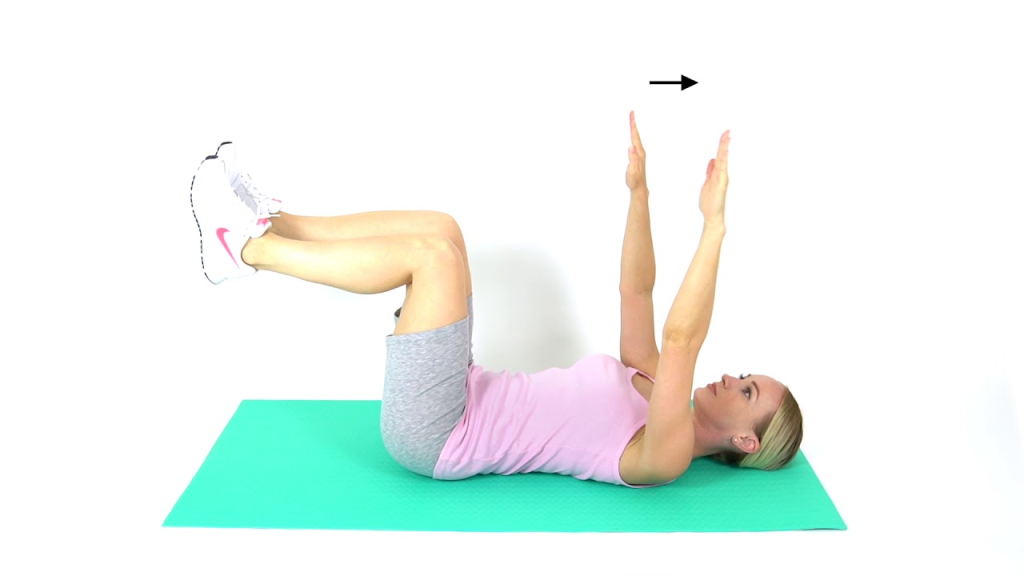Ever heard of a core move that’s gentle on your spine yet fiercely effective? That’s exactly what the Dead Bug delivers—an underrated gem in the world of fitness that’s transforming how women approach core training.
Whether you’re a beginner, a postpartum mom, or simply looking for a joint-friendly ab routine, the 5-minute Dead Bug exercise is a game-changer. It targets your core, improves coordination, and helps prevent back pain—all without crunches, planks, or equipment.

Results After 30 Days of Dead Bug Exercise
| Benefit | What to Expect |
|---|---|
| Core Strength | Noticeably stronger and more stable midsection |
| Improved Posture | Reduced slouching and more upright standing or sitting |
| Lower Back Relief | Less tension and discomfort in the lumbar area |
| Enhanced Balance & Coordination | Better control over limb movements and daily tasks |
| Flatter Abdomen Appearance | Tighter abdominal muscles (even without weight loss) |
| Better Breathing Mechanics | Deeper, more controlled breathing due to diaphragm engagement |
| Stronger Mind-Body Connection | Improved core awareness during movement and exercise |
| More Stability in Daily Movements | Easier bending, lifting, and walking without feeling unstable or strained |
| Gentle Recovery Support | Ideal for postpartum or those easing into fitness, with visible strength returns |
| Consistency in Routine | 5 minutes a day builds long-term exercise habit |
What Is the Dead Bug Exercise?
The Dead Bug is a controlled core-strengthening movement inspired by physical therapy and rehabilitation training. You lie on your back with your arms and legs raised—mimicking a “dead bug”—and move opposite limbs simultaneously while engaging your core.
Despite its odd name, this move is scientifically backed for engaging deep abdominal muscles, like the transverse abdominis, which acts as a natural corset around your waist.
Why Is It Perfect for Women?
Low-impact and safe: Especially beneficial for women dealing with lower back issues or recovering from childbirth.
Engages deep core muscles: Unlike crunches, which focus on the surface-level abs, the dead bug targets stability muscles.
Improves posture and pelvic control: Crucial for desk workers and postpartum recovery.
Boosts mind-body connection: It requires coordination and focus—perfect for building core awareness.
Did You Know?
The Dead Bug is often used by physical therapists to help patients recover from spinal injuries—proving how safe and effective it is for your back.
The 5-Minute Dead Bug Routine
You don’t need an hour. Just 5 minutes a day can deliver visible and functional results if you stay consistent.
Warm-up (30 seconds)

Start with deep breathing while lying on your back. Inhale into your belly, exhale and gently draw your belly button toward your spine to activate the core.
Exercise 1: Basic Dead Bug (1 minute)

How to Do:
- Lie on your back, arms straight toward the ceiling, knees bent at 90 degrees.
- Inhale. As you exhale, lower your right arm and left leg slowly to just above the floor.
- Return to the start and repeat on the opposite side.
✔️ Tip: Keep your lower back pressed to the floor throughout.
Exercise 2: Dead Bug Hold (45 seconds)

Hold the starting dead bug position (arms up, legs lifted) while bracing your core.
This static hold builds endurance in the deep abdominals.
Exercise 3: Slow-Motion Dead Bug (1 minute)

Repeat the basic dead bug, but slow each limb extension to a 5-second count.
This tempo change increases control, and muscle activation, and burns more calories.
Exercise 4: Wall Dead Bug (45 seconds)

Place your hands against a wall with your arms straight. Push into the wall while alternating leg movements.
Engages the core and shoulders while minimizing spinal stress.
Cooldown (1 minute)

Perform a lying spinal twist or child’s pose stretch to release the back and reset the body.
Common Mistakes to Avoid
- Arching the back: Your lower spine should stay glued to the floor to prevent injury.
- Holding breath: Always exhale during limb extension—this activates the deep core.
- Fast, jerky motions: Slower = stronger. Speed kills the benefits.
Myth Buster:
“You need to feel the burn to know it’s working.”
Actually, deep core activation often feels subtle—but it’s way more effective in building long-term stability.
Who Should Try It?
- Women with diastasis recti (postpartum abdominal separation)
- Women over 30 looking to improve balance and core strength
- Women with desk jobs or chronic back pain
- Fitness beginners avoiding high-impact movements
How Often Should You Do the 5-Minute Dead Bug Routine?
For best results, aim for 5 minutes a day, 5 days a week. It’s short enough to stick to but effective enough to make a difference. You can even use it as a warm-up before workouts or a standalone core session.
Interesting Fact:
Research shows that improving deep core activation can also enhance breathing, digestion, and even stress regulation.
Final Thoughts
The Dead Bug exercise might look simple, but don’t be fooled—it’s a core powerhouse. It teaches your body how to brace properly, protect the spine, and move efficiently in daily life.
In just five minutes a day, you’ll notice better posture, a stronger midsection, and improved body awareness—all without ever doing a single crunch. So next time you lie on your back, remember: a little bug can deliver big fitness results.
Frequently Asked Questions (FAQs)
Is the Dead Bug exercise good for beginners?
Yes, absolutely. The Dead Bug is ideal for beginners because it’s low-impact and can be easily modified. It teaches core activation and control without straining the neck or back.
Can I do the Dead Bug exercise daily?
Yes, you can perform the Dead Bug daily, especially since it’s gentle and focused on core stability rather than intense muscle fatigue. Just listen to your body and rest if needed.
Does the Dead Bug help reduce belly fat?
While the Dead Bug strengthens your core, it won’t directly burn belly fat. Fat loss comes from a combination of exercise, nutrition, and overall calorie deficit. However, it tightens and flattens the abdominal wall, improving the appearance of your midsection.
Is the Dead Bug safe during pregnancy or postpartum?
The Dead Bug can be safe during early pregnancy or postpartum recovery, especially with modifications. However, always consult your doctor or a physiotherapist before starting any exercise if you’re pregnant or recently gave birth.
What muscles does the Dead Bug target?
The Dead Bug targets the transverse abdominis, rectus abdominis, obliques, hip flexors, and even the pelvic floor muscles—making it a full core stabilizing movement.
Can it replace crunches or planks?
Yes, for many women, especially those with back or neck discomfort, the Dead Bug is a safer and more functional alternative to traditional crunches or planks.
What equipment do I need for the Dead Bug?
None! It’s a bodyweight exercise. However, as you progress, you can add light dumbbells or a resistance band for an added challenge.
How long does it take to see results?
With consistency (5 minutes a day, 4–5 times a week), most women notice improved core strength, posture, and stability within 2 to 4 weeks.
Can I do this exercise if I have lower back pain?
Yes, and it’s often recommended for that reason. Just ensure your lower back stays in contact with the floor throughout the movement and avoid overextending your limbs.





